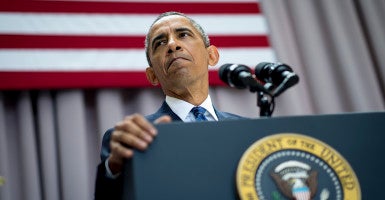You’ve heard the argument. If Congress turns down the Iran nuclear deal, Tehran will rush to get a nuclear bomb within two to three months. Our only alternative then is war.
But what about Congress voting “no” and adjusting the terms of the agreement?
Robert Satloff, the executive director of the Washington Institute for Near East Policy, recently made such a proposal. He argues that congressional disapproval would provide time to correct some of the agreement’s flaws. Most experts believe that it would take until spring 2016 at the earliest for Iran to comply with the terms of the agreement. Since none of the U.S. sanctions will be suspended by then, there would still be time for the U.S. to take remedial measures to strengthen the deal.
Among these could be reaching understandings with the European partners “on the appropriate penalties to be imposed for a broad spectrum of Iranian violations.” Other actions could include a clearer declaratory policy that military force will not be taken off the table and ramping up tougher sanctions against Tehran’s terrorist and other non-nuclear activities that destabilize the region.
Satloff’s alternative is a noble effort to save an obviously weak deal. It recognizes a major flaw in the agreement: that the terms of re-imposing “snapback” sanctions are so onerous that they will likely never be enforced. It also points to a negotiating principle that the Obama administration has tried to obscure: strong sanctions are what forced whatever concessions Iran made. Keeping or strengthening sanctions enhances America’s bargaining leverage. Even if Congress disapproves the deal, that leverage will remain.
This last point is key. We should remember that no sanctions relief kicks in from anybody—including the United Nations and the Europeans—until the IAEA certifies that Iran has complied with its initial commitments under the agreement. If Tehran responds to a congressional “no” vote by thumbing its nose at everybody, it will only be back where it started, which is not where it wants to be. In fact, it could face even stronger sanctions (or worse) from the U.S. if it should hit the accelerator on its nuclear program.
Satloff’s idea is a good start. Unfortunately, it doesn’t go far enough. The only way to get Iran to give up its nuclear program short of war is to force it to decide between retaining its nuclear weapons potential and having sanctions completely lifted. Neither Satloff’s option nor Obama’s deal forces that choice.
Either way, sanctions get lifted while accepting that Iran is on a glide path to becoming a permanent nuclear threshold state in at least 15 years if not earlier. Not only will Iran emerge at the end of that period free of sanctions, but it will also be able to ramp up its uranium enrichment efforts and expand its stockpile of enriched uranium, which will make a final sprint to a nuclear breakout much easier. It will also, because of the agreement, be a substantially stronger regional power, both economically and geopolitically.
The best option for Congress is to reject the deal and force the administration back to the drawing board. All the tougher measures that Satloff outlined could be included and more. If Tehran truly wants sanctions relief, it will have a greater incentive to stick with the talks than to walk away from them. A walk-out would jeopardize all the sanctions relief Iran wants. Sure, the Iranians would bluster and threaten, but they would have no choice but to return to the bargaining table if they want the sanctions eliminated.
This approach may or may not succeed. The secretary of state called the prospects of a better deal a “fantasy.” He’s got it backwards. The real fantasy is the administration’s promise that the current agreement will eliminate Iran’s nuclear capability. The existing deal will not only lead to a nuclear Iran, but to one that is economically fueled with sanctions relief.
Originally published in The Washington Times.






























